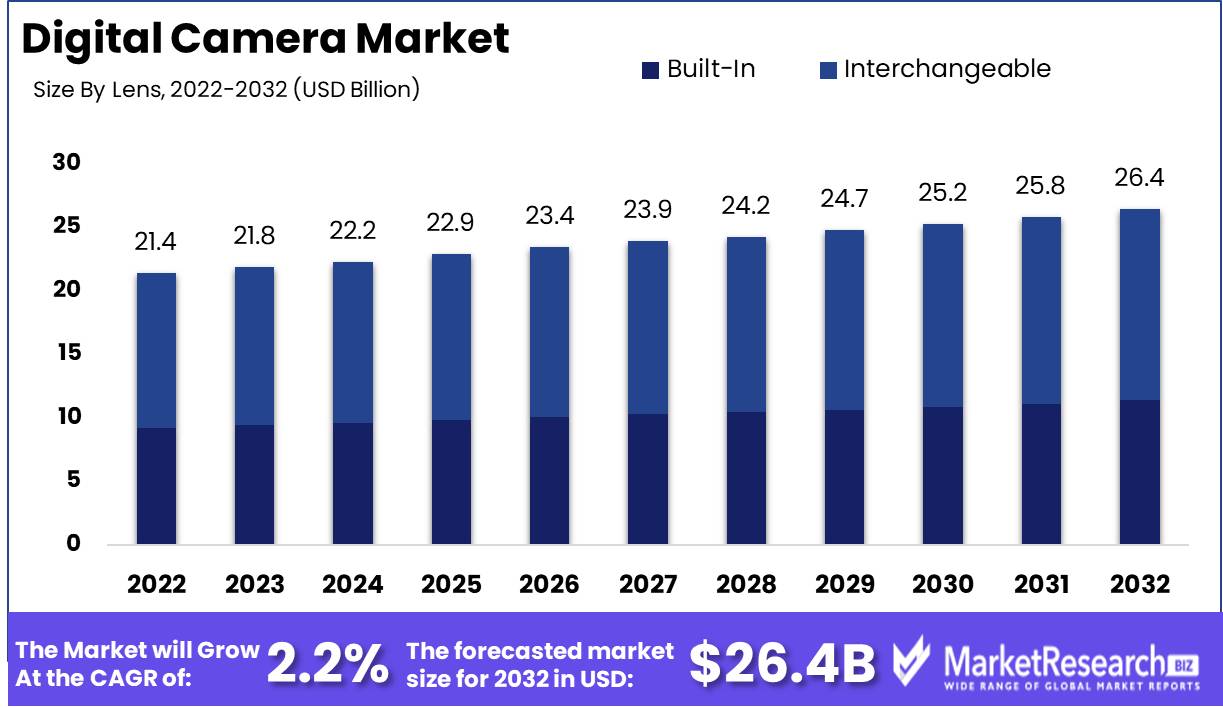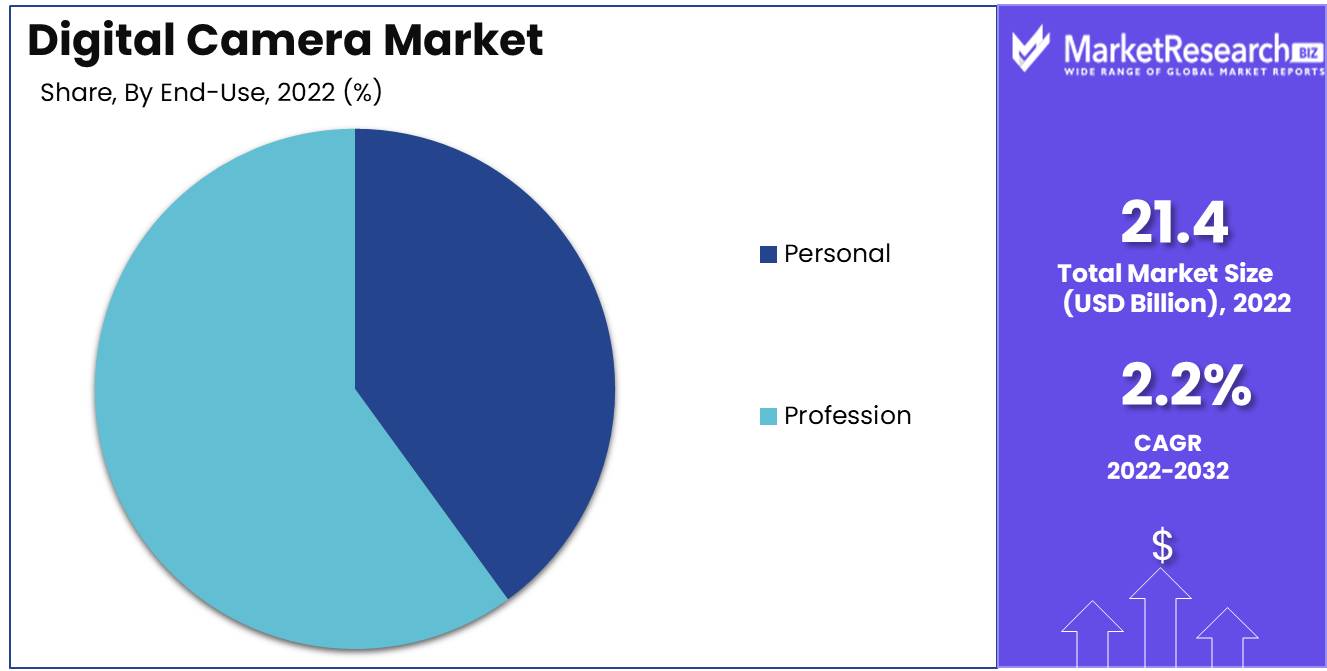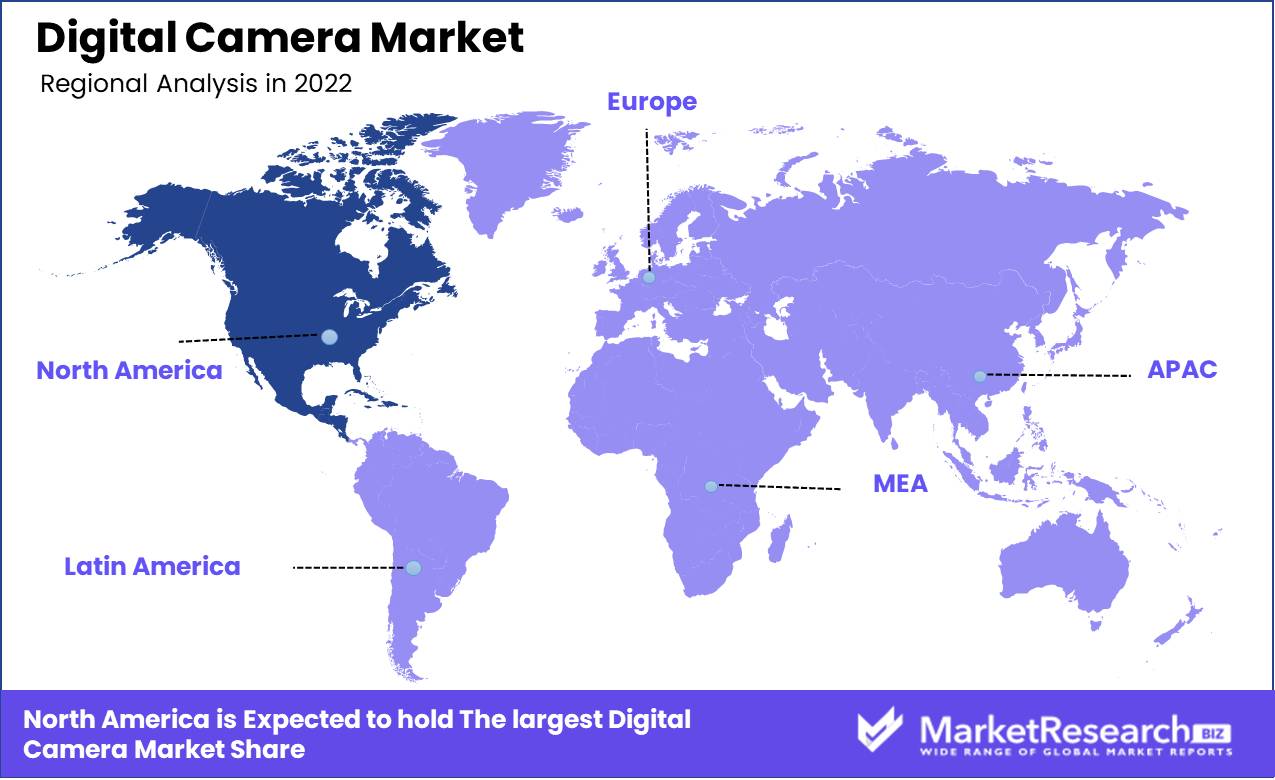
Digital Camera Market By Lens Type (Built-In, Interchangeable), By Camera Type (Compact Digital Camera, DSLR, and Others), By End-Use (Personal, Profession), By Distribution Channel (Online, Offline), By Region And Companies - Industry Segment Outlook, Market Assessment, Competition Scenario, Trends, And Forecast 2023-2032
-
37907
-
June 2023
-
137
-
-
This report was compiled by Research Team Research team of over 50 passionate professionals leverages advanced research methodologies and analytical expertise to deliver insightful, data-driven market intelligence that empowers businesses across diverse industries to make strategic, well-informed Correspondence Research Team Linkedin | Detailed Market research Methodology Our methodology involves a mix of primary research, including interviews with leading mental health experts, and secondary research from reputable medical journals and databases. View Detailed Methodology Page
-
Quick Navigation
Report Overview
Digital Camera Market size is expected to be worth around USD 26.4 Bn by 2032 from USD 21.4 Bn in 2022, growing at a CAGR of 2.2% during the forecast period from 2023 to 2032.
The global digital camera market is a dynamic industry that provides a variety of features, functionalities, and price points to meet the diverse requirements of consumers and businesses. In this overview, we will examine the digital camera market's definition, significance, innovations, investments, growth, applications, industries involved, key drivers, ethical concerns, and responsible practices. We will also examine real-world applications of digital cameras in business contexts.

The digital camera market is extremely competitive and includes a variety of camera models, such as point-and-shoot, DSLR, mirrorless, and action cameras. These electronic devices capture and preserve images, videos, and multimedia content, thereby integrating themselves into our daily lives. One of the primary objectives of the digital camera market is to provide high-quality cameras at reasonable prices, thereby making them accessible to a larger audience. These cameras are designed to capture high-quality photos and videos in a variety of environments and illumination conditions. They have revolutionized how we capture and share moments, making it simpler for individuals to document their lives and share their experiences.
It is impossible to exaggerate the significance of the digital camera market, as it has revolutionized communication in numerous industries, including photography, videography, journalism, and advertising. Digital cameras offer several advantages over conventional cameras, such as instant feedback, simple editing, and storage capacity. They are economical, portable, and user-friendly, making them popular with both consumers and professionals.
The digital camera market has witnessed numerous innovations over the years, such as compact designs, high-resolution sensors, image stabilization, and wireless connectivity. Artificial intelligence (AI) and machine learning (ML) have also made significant contributions to the industry, enabling features such as automatic scene detection, facial recognition, and object tracking. In addition, sophisticated software now enables users to modify and process images directly on the camera.
Despite the fact that digital cameras have brought about numerous advantages, ethical concerns regarding privacy, security, and data protection have emerged. Transparency, explicability, and accountability are required on the digital camera market. Ethical labor practices and the proper disposal of electronic refuse are also crucial for the industry's long-term viability.
Driving factors
The Rapidly Evolving Market Landscape
The digital camera market, a hotbed of technological advancements and innovation, is on the cusp of extraordinary expansion. Unlocking the potential of camera sensors and innovating image processing techniques are the primary forces behind this impending growth. As the demand for high-quality imaging solutions increases, manufacturers are investing heavily in innovative research and development. The result? A new generation of cameras with features that defy the limits of the imagination. Mirrorless and compact camera designs have emerged as the epitome of excellence, capturing the attention of both seasoned photographers and ardent enthusiasts.
The Convergence of Photography and Social Media on the Rise
A kaleidoscope of interests intertwine in the digital camera market, thereby enhancing its prospects. The proliferation of consumer interest in photography, coupled with the ubiquity of social media management platforms, has paved the way for an extraordinary paradigm shift. In a time when every photograph has the potential to be a work of art, people desire cameras that effortlessly produce breathtaking images. A tidal surge of demand for digital cameras with cutting-edge features such as seamless Wi-Fi connectivity and intuitive touch displays has been generated by the desire for excellence. With these technological advancements at their disposal, users are able to capture extraordinary moments and liberate their digital creativity.
Getting Through the Regulatory Maze
In the midst of the flourishing digital camera industry, regulatory changes pose a threat of disruption. As countries consider imposing prohibitions on cameras capable of documenting breathtaking visuals in public spaces, the very fabric of the market may be woven with uncertainty. The repercussions of such decisions could reverberate throughout the industry, compelling manufacturers and distributors to adjust their strategies and refocus on cameras with limitations in particular domains. The ever-changing regulatory climate adds an enticing level of complexity to a market that is already diverse.
The Beginning of Technological Wonders
As the cogs of progress turn, the digital camera market stands on the verge of an era brimming with technological miracles. Emerging technologies like artificial intelligence and machine learning will redefine the capabilities of cameras. A new era has begun, one in which cameras are able to autonomously detect individuals and objects within a scene and adapt their settings accordingly. This fusion of cutting-edge technology and artistic expression will produce digital camera designs that surpass all expectations, thereby expanding the boundaries of innovation.
The Age of Smartphones' Ascent
The relentless march of smartphone technology within the intricate digital camera market threatens to reshape the competitive landscape. Smartphones' increasingly sophisticated camera capabilities have made them formidable competitors in the domain of photography. These devices, which unleash the power of high-quality photo and video capture, have the potential to challenge the dominance of digital cameras. This paradigm shift could lead to a decline in demand for traditional cameras or force manufacturers to transition towards niche markets in a futile attempt to maintain relevance in a constantly evolving ecosystem.
A Future of Innovation and Growth
Growth and innovation intertwine harmoniously in the extensive digital camera market. Manufacturers are engaged in a ceaseless pursuit to meet the evolving requirements and preferences of consumers, and the horizon is rife with unbounded opportunities. With complexity and volatility as their guiding principles, these technological wordsmiths will carve their path, engraving a story of unrivaled development and limitless potential.
Restraining Factors
Conquest of the Competitive Terrain
The digital camera industry is engaged in an intense competition with the constantly improving smartphone cameras. The prevalence of smartphones has enabled users to effortlessly capture spectacular visuals, thereby upending the digital camera market. With their unparalleled image and video quality, digital camera manufacturers must navigate the treacherous waters of competition in order to endure this tempest.
Adopting Specialty Domains
In response to the relentless proliferation of smartphones, digital camera manufacturers are embracing niche markets. They recognize that precision and excellence in photography are crucial for both professionals and amateurs. Digital camera manufacturers can cement their position as the pinnacle of photographic proficiency by refining their focus on catering to the specific requirements of these discerning users.
Breaking the Barrier of Saturation
Once a beacon of consistent growth, the digital camera market is now on the verge of saturating. In conjunction with the debilitating effects of the COVID-19 pandemic, the increase in smartphone utilization has reduced demand. Digital camera manufacturers need to redefine themselves to break the chains of market ennui. They can reignite the flame of growth and capture the affections of photography devotees by delving deeply into niche markets and meticulously crafting products that address specific needs and desires.
Pricing Difficulties
Pricing is an ever-present obstacle, and digital cameras are not immune to its influence. As the appeal of smartphone cameras increases, manufacturers of digital cameras must achieve a delicate equilibrium between price and value proposition. They must navigate the maze of production costs, materials, components, and labor expenses to remain competitive. In order for digital camera manufacturers to offer competitive prices without sacrificing quality, they must optimize their supply chains and leverage economies of scale.
Distribution Difficulties
In the expansive and unexplored territories of emerging markets, distribution becomes a formidable obstacle. Manufacturers of digital cameras must navigate uncharted territory by constructing a robust and extensive distribution network. Collaboration with e-commerce platforms and partnership formation with merchants are crucial strategies for effectively penetrating these markets. They can only win the hearts and minds of photography devotees worldwide by guaranteeing optimal product placement and seamless delivery.
Inventing Despite Adversity
Despite the formidable obstacles, the future is still full of opportunities for digital camera manufacturers. They can rewrite the history of their industry by fostering their creative spirit and embracing innovation. They can redefine the very essence of photography by capitalizing on technological advances, releasing unmatched features, and providing distinctive value propositions. In this unyielding pursuit, the digital camera market will not only survive, but prosper, and continue to serve as a beacon for those who wish to capture the world through their lens.
Lens Type Analysis
The interchangeable lens type is the dominating segment, according to the market analysis of the global digital camera market. This segment is anticipated to maintain its market-leading position in the coming years. The segment's growth can be attributed to a number of factors, including technological advancements, rising demand for high-quality images, and the need for customization options.
The interchangeable segment is designed to satisfy the contemporary consumer's demand for high-quality photographs. The rise of social media, where images are the most commonly shared content, has fuelled this trend. To capture high-quality images that stand out on social media platforms, consumers are now willing to pay a premium for interchangeable-lens cameras. In the coming years, the interchangeable segment of the global digital camera market is anticipated to record the highest growth rate. This anticipated growth rate can be attributed to technological advancements that have made lens replacement simpler and more convenient.
Camera Type Analysis
The DSLR segment dominates the global digital camera market, according to the camera type analysis. This segment is anticipated to maintain its market-leading position in the coming years. The segment's expansion can be attributed to its superior image quality, adjustable settings, and interchangeable lenses.
The consumer behavior and trends surrounding the DSLR market segment have evolved significantly over time. Modern consumers demand high-quality images, and DSLR cameras are designed to satisfy this demand. This trend has been fuelled by the rise of social media, where a significant proportion of consumers have become professional content creators. In the coming years, the DSLR segment of the global digital camera market is anticipated to record the highest growth rate. This expected growth rate can be attributed to the superior image quality, customizable settings, and interchangeable lens capability of DSLR cameras. Demand for DSLR cameras has increased due to an increase in social media usage and the need for high-quality images.
End-Use Analysis
The professional segment dominates the global digital camera market, according to the end-use analysis. This segment is anticipated to maintain its market-leading position in the coming years. Technology advancements have made digital cameras affordable and accessible to professional content creators and photographers, which has contributed to the segment's growth.
In recent years, there have been significant shifts in consumer behavior and market trends toward the professional segment. The number of professional content producers has increased as social media usage has increased. Now, consumers are prepared to invest in digital cameras tailored to their professional requirements. In the future years, the professional segment of the global digital camera market is anticipated to record the highest growth rate. The use of social media has increased demand for professional content creators, and technological advancements have made digital cameras more affordable and accessible.

Key Market Segments
By Lens Type
- Built-In
- Interchangeable
By Camera Type
- Compact Digital Camera
- DSLR
- Mirrorless
- Bridge Camera
- Other Camera Types
By End-Use
- Personal
- Profession
By Distribution Channel
- Online
- Offline
Growth Opportunity
Opportunities and Growth Potential
With the development of high-resolution sensors, enhanced autofocus systems, and the incorporation of wireless connectivity and smart capabilities, the digital camera market has expanded rapidly as technology has advanced. This has led to the expansion of niche photography markets and partnerships between camera manufacturers and software developers. This article will examine the global digital camera market's development potential and opportunities.
Development of Superior Functions
The development of sophisticated features is one of the major factors propelling the growth of the digital camera market. For example, high-resolution sensors enable cameras to capture images with a high level of clarity and detail. In contrast, sophisticated autofocus systems make it simpler for photographers to capture precise images by automatically adjusting the subject's focus. Including these sophisticated features enhances the overall user experience, thereby increasing the demand for digital cameras.
Growth in Photography Niche Markets
The expansion of photography niche markets is an additional growth area for the digital camera market. As a consequence of the advent of social media, people are now more intrigued than ever in photography and image capture. The demand for specialized cameras, such as those used for wildlife and sports photography, is growing. This market segment provides manufacturers with opportunities to produce specialized cameras that accommodate to the specific requirements of end-users.
Integration of Smart Capabilities and Wireless Connectivity
The incorporation of wireless connectivity and intelligent features is reshaping the digital camera market. Given the prevalence of smartphones with high-quality cameras, camera manufacturers must devise strategies to remain competitive on the market. One method is to integrate wireless connectivity and intelligent features that enable users to wirelessly transfer images and videos to their mobile devices. Modern cameras increasingly require the ability to connect to Wi-Fi networks and share photos on social media platforms.
Collaborations between Camera Makers and Software Programmers
Collaborations between camera manufacturers and software developers have greatly contributed to the growth of the digital camera market. The incorporation of sophisticated image modification software into digital cameras has resulted in an increase in demand for high-quality photographs. Moreover, collaborations between camera manufacturers and software developers have led to the incorporation of artificial intelligence features in digital cameras.
Latest Trends
Mirrorless Camera Techniques
The introduction of new mirrorless camera systems is one of the main trends reshaping the digital camera market. In contrast to conventional DSLR cameras, mirrorless cameras eschew the mirror and optical viewfinder in favor of an electronic viewfinder or LCD screen. This makes them smaller, lighter, and more portable, without sacrificing image quality or advanced features.
Designs that are Portable and Small
The demand for compact and portable designs is another factor influencing the digital camera market. Consumers seek compact cameras that do not sacrifice image quality or advanced features for portability. In response, manufacturers are producing compact point-and-shoot cameras with sophisticated optics, potent zoom lenses, and high-quality sensors that rival those of larger DSLR cameras.
Utilization of 4K Technology and Video Capabilities
Adoption of 4K and video capabilities is another significant trend in the digital camera market. With the rise of social media platforms such as Instagram, YouTube, and TikTok, consumers are increasingly searching for video-capable cameras. In response, manufacturers are creating cameras with 4K video capture, high frame rates, and sophisticated video features such as slow motion and time-lapse modes.
User-Friendly Interfaces and Intuitive Controls are emphasized.
Simultaneously, manufacturers place a greater emphasis on user-friendly interfaces and intuitive controls. Touchscreens, streamlined menus, and customizable settings are increasingly incorporated into the design of cameras, making them more user-friendly for both amateur and professional photographers. Some companies are even incorporating artificial intelligence and voice control into their cameras to make them more user-friendly and accessible.
Regional Analysis
North America dominates the Digital Camera Market. In recent decades, digital cameras have dominated the market, superseding the prevalence of traditional film cameras. Due to the proliferation of social media platforms and the need to share high-quality images, digital cameras have become indispensable for documenting and preserving life's moments. The North American Digital Camera Market has contributed significantly to this trend, solidifying the region's position at the vanguard of the industry.
Numerous of the world's leading camera brands and manufacturers are headquartered in the United States and Canada, which have long been at the vanguard of the digital camera industry. This dominance has been made possible by a number of factors, including a robust and technologically advanced research and development sector, a highly trained workforce, and a robust consumer market for high-quality photography equipment.
The region's lengthy history of technological innovation is one of the primary factors contributing to North America's dominance in the digital camera market. This is especially true in the United States, which has a well-established research and development infrastructure that encourages innovation and technological advancement. This environment has greatly benefited the digital camera industry, with key participants such as Canon, Nikon, and Sony maintaining a strong presence in the country.
The region's highly qualified workforce has also played a significant role in the success of the digital camera industry in North America. The United States and Canada are home to some of the most skilled and well-educated individuals in the technology sector, with many of these professionals specializing in photography and camera development. Significant improvements in the quality and dependability of digital cameras have resulted from the contributions of this talented collection of individuals.

Key Regions and Countries
North America
- US
- Canada
- Mexico
Western Europe
- Germany
- France
- The UK
- Spain
- Italy
- Portugal
- Ireland
- Austria
- Switzerland
- Benelux
- Nordic
- Rest of Western Europe
Eastern Europe
- Russia
- Poland
- The Czech Republic
- Greece
- Rest of Eastern Europe
APAC
- China
- Japan
- South Korea
- India
- Australia & New Zealand
- Indonesia
- Malaysia
- Philippines
- Singapore
- Thailand
- Vietnam
- Rest of APAC
Latin America
- Brazil
- Colombia
- Chile
- Argentina
- Costa Rica
- Rest of Latin America
Middle East & Africa
- Algeria
- Egypt
- Israel
- Kuwait
- Nigeria
- Saudi Arabia
- South Africa
- Turkey
- United Arab Emirates
- Rest of MEA
Key Players Analysis
The digital camera industry has experienced tremendous development, with new competitors entering the market and established companies innovating their products and services. Presently, Canon, Sony, Nikon, Fujifilm, Olympus, Samsung, and Panasonic are some of the main participants in the global digital camera market.
Canon, with a market share greater than 20%, is the industry frontrunner in digital cameras. The company's cameras are renowned for their superior image quality, high-resolution image sensors, and outstanding performance. Canon accommodates to various user segments, from amateur to professional photographers, making it a formidable market competitor.
Sony, a Japanese multinational corporation, is renowned for its line of technologically sophisticated digital cameras. With their high-resolution sensors, quick autofocus, and superior video capabilities, the company's full-frame mirrorless cameras have revolutionized the market.
Nikon, another well-known Japanese brand, is renowned for its user-friendly camera bodies, precise autofocus, and exceptional image quality. The company's inventory of digital cameras includes options for both amateur and professional photographers, meeting the requirements of a wide range of customers.
The Japanese multinational photography and imaging company Fujifilm has also made its imprint in the digital camera market. Users have been impressed by the compact design, exceptional color reproduction, and innovative features of the company's mirrorless camera lineup.
Olympus is another major participant in the digital camera market, with a variety of mirrorless cameras that feature robust image stabilization, programmable controls, and remarkable features.
Samsung, a multinational conglomerate based in South Korea, offers a variety of digital cameras with inventive features, such as Wi-Fi connectivity. With their high-resolution sensors and quick autofocus, the company's digital cameras cater to amateur and professional photographers.
Panasonic, a transnational electronics corporation, has a strong presence in the digital camera industry with its array of mirrorless cameras that feature high-quality video capabilities, quick autofocus, and intuitive user interfaces.
Top Key Players in Digital Camera Market
- Nikon Corporation
- Canon, Inc.
- Panasonic Corporation
- Fujifilm Holdings
- Sony Corporation
- Olympus Corporation
- Samsung Electronics Co., Ltd.
- GoPro, Inc
- Kodak
- Other Key Players
Recent Development
In 2023, Canon introduced a mirrorless camera system to the global digital camera market. This innovative camera system has superior features and technology that make it stand out in the market. Canon's revolutionary mirrorless camera system has attracted photographers worldwide with its cutting-edge technology and attractive aesthetics.
In 2023, Nikon released a new DSLR camera. Nikon's latest DSLR camera has cutting-edge functionality. The camera's strong sensor and cutting-edge technologies let photographers take breathtaking photos and films.
In 2023, Sony released a new point-and-shoot digital camera. Sony's latest camera is ideal for mobile photographers. Sony's point-and-shoot camera is perfect for capturing life's priceless moments.
Report Scope:
Report Features Description Market Value (2022) USD 21.4 Bn Forecast Revenue (2032) USD 26.4 Bn CAGR (2023-2032) 2.21% Base Year for Estimation 2022 Historic Period 2016-2022 Forecast Period 2023-2032 Report Coverage Revenue Forecast, Market Dynamics, COVID-19 Impact, Competitive Landscape, Recent Developments Segments Covered By Lens Type (Built-In, Interchangeable)
By Camera Type (Compact Digital Camera, DSLR, Mirrorless, Bridge Camera, Other Camera Types)
By End-Use (Personal, Profession)
By Distribution Channel (Online, Offline)Regional Analysis North America – The US, Canada, & Mexico; Western Europe – Germany, France, The UK, Spain, Italy, Portugal, Ireland, Austria, Switzerland, Benelux, Nordic, & Rest of Western Europe; Eastern Europe – Russia, Poland, The Czech Republic, Greece, & Rest of Eastern Europe; APAC – China, Japan, South Korea, India, Australia & New Zealand, Indonesia, Malaysia, Philippines, Singapore, Thailand, Vietnam, & Rest of APAC; Latin America – Brazil, Colombia, Chile, Argentina, Costa Rica, & Rest of Latin America; Middle East & Africa – Algeria, Egypt, Israel, Kuwait, Nigeria, Saudi Arabia, South Africa, Turkey, United Arab Emirates, & Rest of MEA Competitive Landscape Nikon Corporation, Canon, Inc., Panasonic Corporation, Fujifilm Holdings, Sony Corporation, Olympus Corporation, Samsung Electronics Co., Ltd., GoPro, Inc, Kodak, Other Key Players Customization Scope Customization for segments, region/country-level will be provided. Moreover, additional customization can be done based on the requirements. Purchase Options We have three licenses to opt for: Single User License, Multi-User License (Up to 5 Users), Corporate Use License (Unlimited User and Printable PDF) -
-
- Nikon Corporation
- Canon, Inc.
- Panasonic Corporation
- Fujifilm Holdings
- Sony Corporation
- Olympus Corporation
- Samsung Electronics Co., Ltd.
- GoPro, Inc
- Kodak
- Other Key Players




